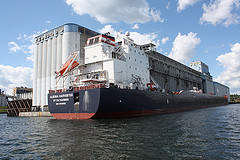The following is the text of a news release from the Chamber of Marine Commerce:
(OTTAWA) — A new study released today reveals that $7 billion is being spent on asset renewal and infrastructure improvements in the bi-national Great Lakes-St. Lawrence shipping system.
The investment survey, compiled by maritime trade consultants, Martin Associates, tallies $6.9 billion in capital spending on ships, ports and terminals and waterway infrastructure in the Great Lakes and St. Lawrence waterway.
Of that total, $4.7 billion has been invested in the navigation system from 2009-2013 and another $2.2 billion is committed to improvements from 2014-2018. Two-thirds of the capital (67 percent) was invested by private companies with 33 percent coming from government funding.
Among the most significant investments, American, Canadian and international shipowners are spending $4 billion on the biggest renewal of the Great Lakes-St. Lawrence fleets in 30 years. The U.S. and Canadian federal governments, through respectively the Saint Lawrence Seaway Development Corp. and the St. Lawrence Seaway Management Corp.n, have dedicated close to $1 billion to modernize the seaway’s lock infrastructure and technology over the 10-year period — the seaway’s most significant transformation in five decades. And Great Lakes and St. Lawrence River ports and terminals are also collectively investing more than $1.7 billion on expanding their docks, equipment, facilities and intermodal connections.
The bi-national Chamber of Marine Commerce, one of the trade associations that commissioned the survey, adds that the right regulatory climate has been key for the flurry of capital expenditures, citing New York state’s decision to not move ahead with unachievable standards for ballast water treatment systems, which would have effectively blocked marine ships from passing through the St. Lawrence Seaway, as a prime example.
Quotes
Stephen Brooks, president, Chamber of Marine Commerce — “These private and public investments are a tremendous show of confidence in the future of the Great Lakes-seaway, a transportation gateway facilitating $35 billion in trade and supporting 227,000 jobs in the U.S. and Canada. To keep that momentum going we will be working closely with our stakeholders and governments to make sure the right regulatory and investment climate exists for further economic growth and environmental improvements.”
Vanta Coda, executive cirector of the Duluth Seaway Port Authority — “The results of this study confirm what we’ve always suspected, that this inland waterway has an attractive return on investment which serves to encourage significant financial outlays by public and private sector alike. At the Port of Duluth-Superior alone, we’ve seen upwards of $40 million of work undertaken by terminals in recent years and another $30 million of infrastructure investment on the horizon for 2015-16. The Port Authority is launching its own redevelopment venture this spring with a $16 million Dock C&D Intermodal Project. Growing freight demands will continue to seek outlets; these investments point to a robust future for our Great Lakes-seaway system as it should be first on the list for open, available capacity.”
Sean Donnelly, president and CEO, ArcelorMittal Dofasco — “The Great Lakes and St. Lawrence Seaway are integral to ArcelorMittal's steel and mining facilities in both Canada and the United States as we utilize shipping for millions of tons of both raw materials and finished products. Our supply chain, which includes shippers that move our material, is critical to our business. Investments in fleet renewal with environmental, productivity and efficiency gains as well as reliability and availability improvements to infrastructure contribute to our business success and to the sustainability and profitability of the entire marine transport supply chain.”
John Buboltz, AVP of Merchandising and Transportation, Cargill Inc. — "The Great Lakes-St. Lawrence shipping system is a critical component of our broader transportation infrastructure in North America. We need to recognize that future growth in the agriculture and food economy sector depends on efficient shipping systems."
Allister Paterson, president of Montreal-based Canada Steamship Lines — "More than $2 billion is now being spent on new ships and vessel upgrades to establish a more efficient, greener and safer Canadian-flag fleet. This not only benefits our U.S. mining, agricultural, construction and manufacturing customers but also those who live in communities throughout the Great Lakes and St. Lawrence River region.”

